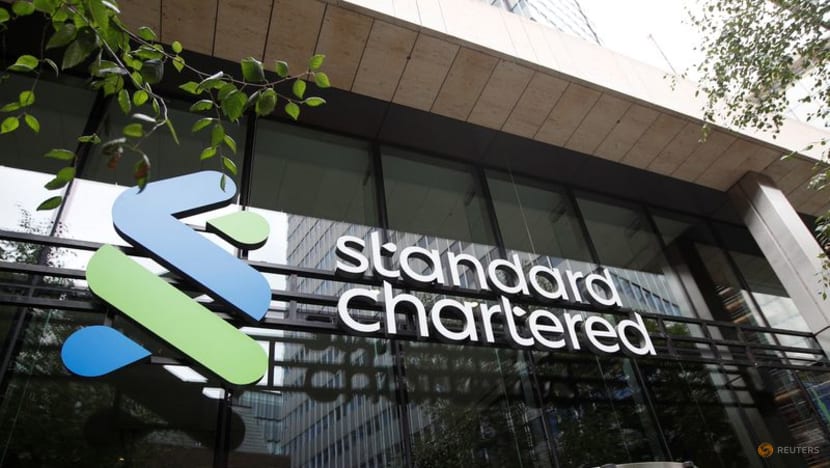Standard Chartered Bank to lower maximum interest rate on savings account to 7.68% from May 1
This is down slightly from 7.88 per cent – the highest offered by Standard Chartered for its Bonus$aver account.

The Standard Chartered bank logo is seen at their headquarters in London, Britain, on Jul 26, 2022. (Photo: REUTERS/Peter Nicholls)

This audio is generated by an AI tool.
SINGAPORE: Standard Chartered Bank will lower the maximum interest rate on its Bonus$aver account to 7.68 per cent per annum from May 1, based on a check of its website on Tuesday (Apr 2).
This is down slightly from 7.88 per cent – the highest offered by the savings account – when the bank last hiked its interest rates in January last year.
Like the high-yield savings accounts offered by other banks, account holders of Standard Chartered’s Bonus$aver need to fulfil several criteria to earn the bonus interest rates.
These include crediting a salary of at least S$3,000 (US$2,217), spending on a card linked to the account and conducting other transactions with the bank, such as investments and bill payments. The bonus interest rates are offered on the first S$100,000 of savings.
With the latest revision, Standard Chartered’s account holders will earn an interest rate of up to 0.6 per cent a year when they spend at least S$500 monthly with their Bonus$aver credit and debit cards, down from the current 1.25 per cent.
The rate for customers who spend at least S$2,000 monthly will also be cut to 1.4 per cent from 2 per cent.
The bonus interest rate for the crediting of salaries is set to be lowered to 2 per cent a year, compared with the current 2.5 per cent.
Account holders also earn bonus interest when they make three eligible bill payments of at least S$50 each in a month via the bank’s online banking platform or Giro. However, this will be reduced to 0.23 per cent from 0.33 per cent.
That said, Standard Chartered is raising the bonus interest for the investment and insurance categories to 2 per cent per annum, compared with the current 1.5 per cent.
This will allow its customers to “still be able to benefit from an attractive rate of up to 7.68 per cent on their deposits of up to S$100,000”, a bank spokesperson told CNA.
In the same announcement posted on its website on Apr 1, Standard Chartered said it is also revising certain interest rates offered by its Wealth $aver Account, which is exclusively for its priority banking and priority private clients who deposit a minimum of S$200,000, as well as its USD$aver Account.
“We regularly review our rates and adjust them according to market conditions, while ensuring that they remain competitive,” the spokesperson said. “We remain committed to supporting our clients in their wealth building journey.”
Standard Chartered is hardly alone in revising down interest rates for its savings accounts.
Local lender UOB will be slashing the interest rates for its UOB One account from May 1, citing the need “to align with long-term interest rate environment expectations”.
Currently, the bank offers the maximum interest rate of 7.8 per cent per annum on account balances between S$75,000 and S$100,000 when customers meet the salary and card spending criteria. But from May 1, that rate will be lowered to 4.5 per cent a year.
UOB will also be introducing two new balance tiers from May 1, although customers will need to have balances above S$100,000 and meet the salary and spending criteria to qualify.
For example, interest earned on balances between S$100,000 to S$125,000 will go up to 4.5 per cent per annum from the current 0.05 per cent.
Savings amounts between the S$125,000 and S$150,000 tier will earn the maximum bonus interest rate of 6 per cent a year, up from the existing 0.05 per cent.
In response to CNA’s queries, DBS and OCBC did not indicate any changes to their savings account interest rates. Both local lenders said they are monitoring the interest rate environment and that they remain committed to offering products that meet the needs of their customers.
In late 2022, the lenders made aggressive hikes to the interest rates on their savings accounts and fixed deposits, as they compete for deposits amid a rising rate environment.
That is now set to change.
High interest rates, while good for savers, typically slow down economic activities as borrowing for these business and industrial activities also becomes more costly, said Singapore Management University (SMU) assistant professor of finance Aurobindo Ghosh.
“When economies are looking to grow, they would look at central banks to cut rates if inflation is in check,” he added. “As it is a competitive market, it makes sense for other banks to follow suit.”
At its last policy meeting, the US central bank left its benchmark overnight interest rate unchanged while holding onto its outlook for three cuts in borrowing costs this year.
This outlook signals that bank deposit rates might be among the first to be cut, said Asst Prof Ghosh, who is also director of the Citi Foundation-SMU Financial Literacy Program for Young Adults.
On the other hand, a drop in borrowing rates may not happen so soon, as banks make money from the difference in interest they get from their loans and pay on deposits.
The decision to cut interest rates for savings accounts could also be strategic decisions taken on by individual banks, as they weigh their individual liquidity needs. For instance, a bank could already have enough deposits that they can deploy to lending.
But given market competition, it is likely that other banks could follow suit with changes in their savings account interest rates, depending on how much deposits they have or need to acquire, said Asst Prof Ghosh.
















